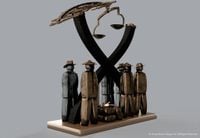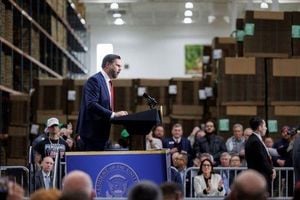On a brisk morning in Seattle’s Pioneer Square, the city’s past and present are set to converge in a striking new way. Next year, a monumental sculpture titled “Exclusion, Expulsion, Expunge” will rise in the heart of the city, commemorating a dark but pivotal moment in Seattle’s history—the 1886 anti-Chinese riot that forcibly expelled hundreds of Chinese immigrants from their homes. As the city prepares to welcome the world for the 2026 FIFA World Cup, this public art installation aims to ensure that a story long overlooked will finally be told to the thousands who will descend upon Seattle.
The sculpture, created by Seattle artist Stewart Wong, is the realization of the Wing Luke Museum’s Chinese American Legacy Art Project (CALAP). According to reporting from the Wing Luke Museum and The Seattle Times, the piece features six life-size bronze figures, three representing Chinese laborers and three depicting members of the angry mob that drove them out. The two groups are separated by a dramatic 14-foot-tall stainless steel “X,” from which the scales of justice hang, their beam forged from firearms. The scales are tipped toward the mob, an unflinching reminder of the imbalance of power that defined the day.
“The biggest challenge for me is to create an impactful art installation, considering the importance of this historical event that still resonates with what is happening politically today, [and] to create an installation that provides a visual narrative to a forgotten, overlooked historical Seattle event,” Wong said at a recent press conference, as quoted by The Seattle Times. The figures themselves are symbolic, with the Chinese laborers cast in brown bronze—two wearing field worker hats and the third a Western-style hat, nodding to the forced assimilation Chinese immigrants faced. The mob, meanwhile, is rendered in black bronze, their cowboy hats marking them as part of the American West’s mythology, but here, they’re cast as antagonists.
The story behind the sculpture is as layered as its design. On February 7, 1886, anti-Chinese sentiment in Seattle reached a fever pitch. As reported by the Wing Luke Museum, an angry mob rounded up 350 Chinese immigrants, forcibly removing them from their homes and expelling them from the city’s original Chinatown. This was not an isolated incident, but part of a broader movement—fueled by the Chinese Exclusion Act of 1882, which banned Chinese laborers from entering the United States and prevented those already here from becoming citizens. The law, according to historical accounts, institutionalized anti-Chinese prejudice and set a grim precedent for future immigration policy.
Doug Chin, a local historian and activist, conceived the idea for the memorial over two decades ago. He and others, including community organizer Bettie Luke, formed CALAP with the aim of honoring this painful chapter of Seattle’s history. Wong, a Cornish College alum and longtime Seattle resident, was commissioned by CALAP in 2020, but had been encouraged by Luke to watch for the art call as far back as 2004. The project’s journey from concept to reality has been a marathon, not a sprint.
Funding, too, has been a challenge. The $500,000 project has raised nearly 60% of its goal, thanks to significant contributions from the city of Seattle and the local Chinese American community. A recent $50,000 donation from the Seattle FIFA World Cup 2026 local organizing committee has provided a crucial boost, as reported by The Seattle Times and the museum’s press releases. Wren Wheeler, civic engagement specialist at the Wing Luke Museum, acknowledged the struggle, stating, “It has been a struggle to obtain the needed funds to complete this project, but we are very close to obtaining the needed funds to realize it.”
To spur further donations, a community match challenge was announced alongside the FIFA committee’s gift, urging residents to give what they can. The timing is no accident. With FIFA set to host six World Cup matches in Seattle between June and July 2026—an event expected to draw 750,000 visitors—CALAP hopes the installation will greet a global audience, sharing not just Seattle’s soccer fever, but its complex, sometimes painful, history.
“Hosting the World Cup gives us a platform to share Seattle’s full story with the world—including the chapters that are painful to confront,” Peter Tomozawa, CEO of Seattle FWC26, said in a press release. “When visitors come to Seattle next summer, we want them to see more than just great soccer—we want them to see a city that faces its history honestly and honors the communities who built it.”
The statue’s location has been a subject of debate. Originally planned for the waterfront along Alaskan Way—where rioters once gathered Chinese immigrants for deportation—the project may now move a few blocks away to Occidental Square, pending city and neighborhood approval. This site, too, is steeped in history, as it was another point of removal for Chinese residents.
The legacy of exclusion and expulsion is not unique to Seattle. Look Tin Eli’s story, detailed in a recent column by Kelley House Museum curator Averee McNear for Mendocino Voice, echoes the broader struggles of Chinese Americans in the late 19th and early 20th centuries. Born in Mendocino in 1870, Look Tin Eli was sent to Guangzhou, China, for education at age nine, a common practice among Chinese immigrant families. When he returned to the U.S. in 1884, anti-Chinese sentiment had hardened into law with the passage of the Chinese Exclusion Act. Unable to provide proof of prior residency—a requirement that hadn’t existed when he left—he was detained at Angel Island for 21 days.
Look Tin Eli’s family, with the support of Chinese community groups, hired attorney Thomas Riordan, who argued in court that Look Tin Eli was a citizen under the Fourteenth Amendment, which grants citizenship to anyone born in the U.S. Justice Stephen Field ultimately ruled that children born in America were citizens regardless of ancestry, enabling Look Tin Eli to return to Mendocino. Later, he moved to San Francisco, where he founded the city’s first Chinese-American bank and played a pivotal role in rebuilding Chinatown after the devastating 1906 earthquake. His case would later serve as precedent for the landmark 1898 United States vs Wong Kim Ark decision, which affirmed the constitutional principle of birthright citizenship.
As Dylan Hartono, a member of the CALAP governing committee, observed at the recent press conference, “The event sheds light on the mistreatment endured by early Chinese immigrants, and unfortunately, subsequent immigrants. It draws parallels towards what is happening today, and we don’t want that in Seattle.”
The “Exclusion, Expulsion, Expunge” installation is more than a memorial to the past; it is a call to remember, to reckon, and to ensure that such injustices are never repeated. As Seattle prepares to welcome the world, it does so with an honest acknowledgment of the communities who built it—and the challenges they endured along the way.




